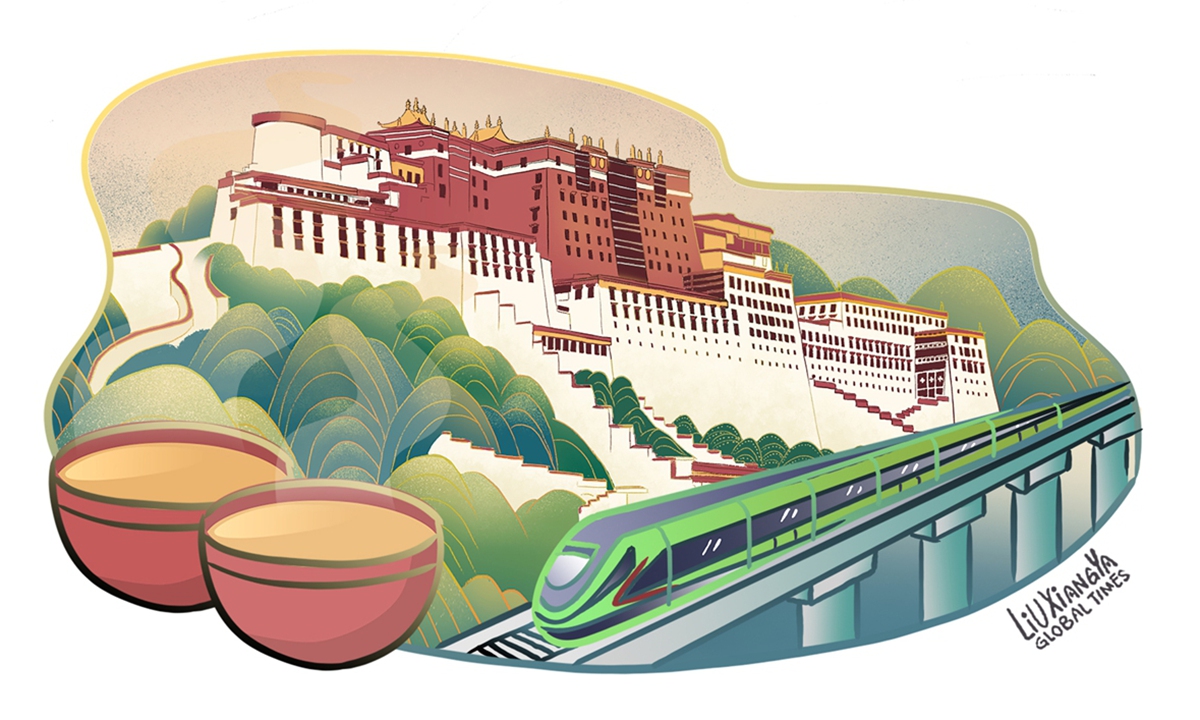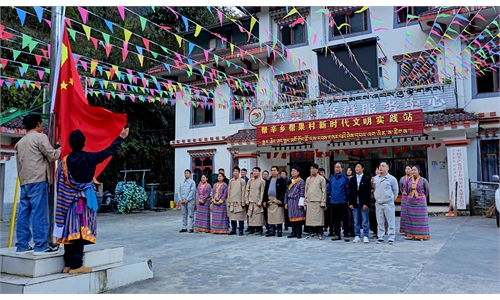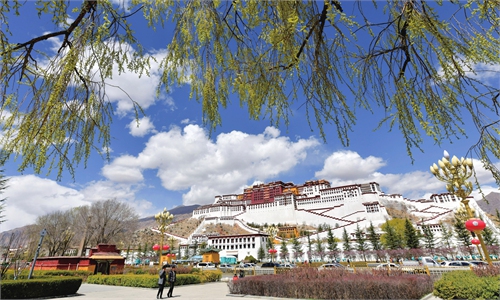My Xizang field trip tells a story different from the West’s lies about the region

Illustration: Liu Xiangya/Global Times
Editor's Note:
Over the past decades, Southwest China's Xizang Autonomous Region has experienced a period of unprecedented development. This year marks the 65th anniversary of Serfs' Emancipation Day, a day to commemorate the emancipation of more than one million serfs in Xizang in 1959. Xizang, once plagued by poverty and backwardness, is now embarking on a new journey of modernization. This huge change astonished Canadian author and journalist Arnold August (August), who visited Xizang and neighboring Qinghai Province last year. He shared with Global Times (GT) reporter Xia Wenxin his experiences during his field trip to this region as well as his thoughts on its development.
GT: You visited Xizang and Qinghai in the second half of last year. Can you share with us what you saw in these regions? What aspect of their development impressed you the most?
August: Our visit to a boarding school in Gonghe county in the largely Tibetan-speaking Hainan Tibetan Autonomous Prefecture in Qinghai Province provided us with an eyewitness account to counter the allegations to which you refer. There are so many positive and enlightening features of this school that people in Western countries should know about.
Based on transparent and open-ended questions and answers during the tour of the classrooms (education is free), the dormitories (modern and well-equipped), the sports fields, the cafeteria (great health manual), the state-of-the-art multimedia rooms and classrooms, the exercise facilities for both the teachers and students, and much more, the veil of "mystery" surrounding boarding schools was completely torn apart. I asked our hosts about the dormitories. The very term "boarding school" in North America rightly conjures up images of colonial genocide against indigenous peoples. But the answer was: "Normally, students sleep in the dormitories during the week. It's convenient for their studies, in terms of time, and if they have any questions, they can just go and ask their teachers. Most students go home for the weekend. However, if they want to stay in school on the weekends, it's okay - they can stay if they want to."
In response to the sub-question about why Western forces want to create these lies about boarding schools, in brief, it is to discredit Chinese socialism. People in the West are increasingly looking for an alternative to capitalism. China does not present itself as a model. But China's earth-shattering modernization and its cultural progress - in the broad sense of a civilized, peaceful, collective society, as opposed to the American individualistic jungle - is increasingly attractive. Hence the inevitable spoiler: "What about the boarding schools in Tibet?" We counter what we call "whataboutism" by turning the tables on the skeptics, by asking "what about" the universally recognized facts of the Canadian and American states' responsibility in the actual genocide of the first peoples in the boarding schools? And side by side, we present the facts about China, based on firsthand evidence by visitors and analysts.
GT: There is a view that Xizang is a microcosm of China's achievements in construction and development and an all-encompassing window into Chinese modernization. Do you agree with this? How does the development of Xizang reflect the characteristics of Chinese modernization?
August: Yes, this view is supported by our visits to several such sites as examples of Chinese achievements. But let's focus on one, the National Innovation Base, which is a long bus ride from Lhasa. It was built by the local government in 2017. Its basic purpose is to give post-university young people the opportunity to build their own businesses or, in the words of the hosts there, to build their own dreams. They are provided with free office space for a period of three years. Water, electricity and housing fees are covered by the government. They told us that "the young people just need to bring their computers and start working here. Everyone has access to the site's online platform to sell their products."
This center is not only an example of China's achievements in construction and development and a comprehensive window on Chinese modernization, but it is also an example of socialism with Chinese characteristics. In short, this innovative path seeks to avoid the extremes of full public ownership of the means of production and a planned economy. How does it do this? It does this by redefining the relationship between state ownership and individual effort with the goal, as our hosts told us, of "realizing dreams." Thus, while all the conditions for individual success are created, the individual is also socialized. It is thus an example of the balance between state and market, a sine qua non for further Chinese modernization.
GT: On March 28, 1959, the central government led the people in Xizang to launch democratic reform, abolishing Xizang's feudal serfdom under a theocracy. After learning about this part of the history, how do you see the life of the Tibetan people after 65 years?
August: As part of the preparation for our field trip, I was able to acquire a documentary on the social and economic reality of Xizang from 1951 to 1959, to which Zhaxi Wangdui, a Tibetan cameraman, contributed significantly. Replete with videos, the documentary tells how the ruling class consisted of three groups of landowners: feudal officials, aristocrats and upper-class lamas. They represented only 5 percent of Xizang's total population, while serfs made up 95 percent of the population. The ruling 5 percent controlled most of the arable land, pastures, forests, mountains, rivers, wetlands and most of the agricultural tools and livestock. The remaining 95 percent of the population, who were slaves and serfs (they themselves were the property of the serf owners) had neither land nor pasture. They had to work for the serf owners and paid land rent to them.
Everywhere we went [in Xizang], in museums and other venues, we saw footage and photos of Tibetans joyfully burning the legal documents that kept them in serfdom for centuries. As a result, March 28 was declared Serfs' Emancipation Day. The day was designated to commemorate the historic date in 1959 when one million serfs were freed in Xizang.
Our hosts were proud to tell us that absolute poverty was eliminated by the end of 2019. While this is an amazing achievement in the rest of China, given the harsh social-economic Tibetan conditions, it is nothing short of a miracle.
Many Western media and governments tend to respond to these achievements, such as the elimination of extreme poverty, by saying, "But at what cost?" As usual, they infer from their preconceived notions that this poverty alleviation program was imposed on the people, somehow at the expense of their cultural heritage and language. Nothing could be further from the truth. For example, our visits included the Xizang University, the Xizang Museum and a school dedicated to promoting traditional Tibetan culture to youth through music and dance. Moreover, a simple stroll through the streets of Lhasa confirms this. Furthermore, our regular daily interactions with the Tibetan guide, who was with us the entire time from Beijing to Lhasa and back to Beijing, showed his pride in the Tibetan heritage as well as the Chinese government.


